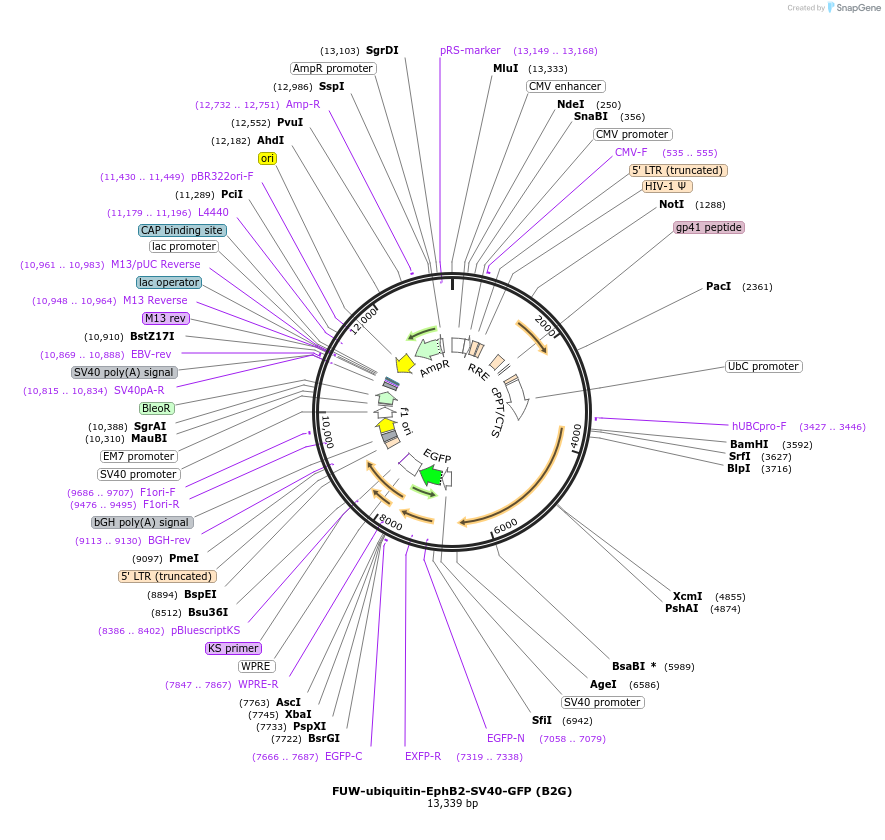-
PurposeExpression of mouse EPHB2 and GFP in mammalian cells
-
Depositing Lab
-
Sequence Information
Ordering
| Item | Catalog # | Description | Quantity | Price (USD) | |
|---|---|---|---|---|---|
| Plasmid | 65442 | Standard format: Plasmid sent in bacteria as agar stab | 1 | $89 | |
Backbone
-
Vector backboneFUW
-
Backbone manufacturerAddgene Plasmid 14882
- Total vector size (bp) 10365
-
Vector typeMammalian Expression, Lentiviral
Growth in Bacteria
-
Bacterial Resistance(s)Ampicillin, 100 μg/mL
-
Growth Temperature37°C
-
Growth Strain(s)Stbl3
-
Copy numberHigh Copy
Gene/Insert
-
Gene/Insert nameEPHB2
-
SpeciesM. musculus (mouse)
-
Insert Size (bp)2984
-
MutationSee depositor comments below.
-
Entrez GeneEphb2 (a.k.a. Cek5, Drt, ETECK, Erk, Hek5, Nuk, Prkm5, Qek5, Sek3, Tyro5)
- Promoter UBQ
-
Tag
/ Fusion Protein
- SV40-EGFP (C terminal on insert)
Cloning Information
- Cloning method Restriction Enzyme
- 5′ cloning site BamHI (not destroyed)
- 3′ cloning site AgeI (not destroyed)
- 5′ sequencing primer hUBCpro-F
- 3′ sequencing primer EGFP-N
- (Common Sequencing Primers)
Terms and Licenses
-
Academic/Nonprofit Terms
-
Industry Terms
- Not Available to Industry
Trademarks:
- Zeocin® is an InvivoGen trademark.
Depositor Comments
Protein sequence for EphB2 matches NCBI AAB30284.1. Plasmid should function as described in the associated publication.
These plasmids were created by your colleagues. Please acknowledge the Principal Investigator, cite the article in which the plasmids were described, and include Addgene in the Materials and Methods of your future publications.
-
For your Materials & Methods section:
FUW-ubiquitin-EphB2-SV40-GFP (B2G) was a gift from Eduard Batlle (Addgene plasmid # 65442 ; http://n2t.net/addgene:65442 ; RRID:Addgene_65442) -
For your References section:
EphB-ephrin-B interactions suppress colorectal cancer progression by compartmentalizing tumor cells. Cortina C, Palomo-Ponce S, Iglesias M, Fernandez-Masip JL, Vivancos A, Whissell G, Huma M, Peiro N, Gallego L, Jonkheer S, Davy A, Lloreta J, Sancho E, Batlle E. Nat Genet. 2007 Nov;39(11):1376-83. Epub 2007 Sep 30. 10.1038/ng.2007.11 PubMed 17906625



